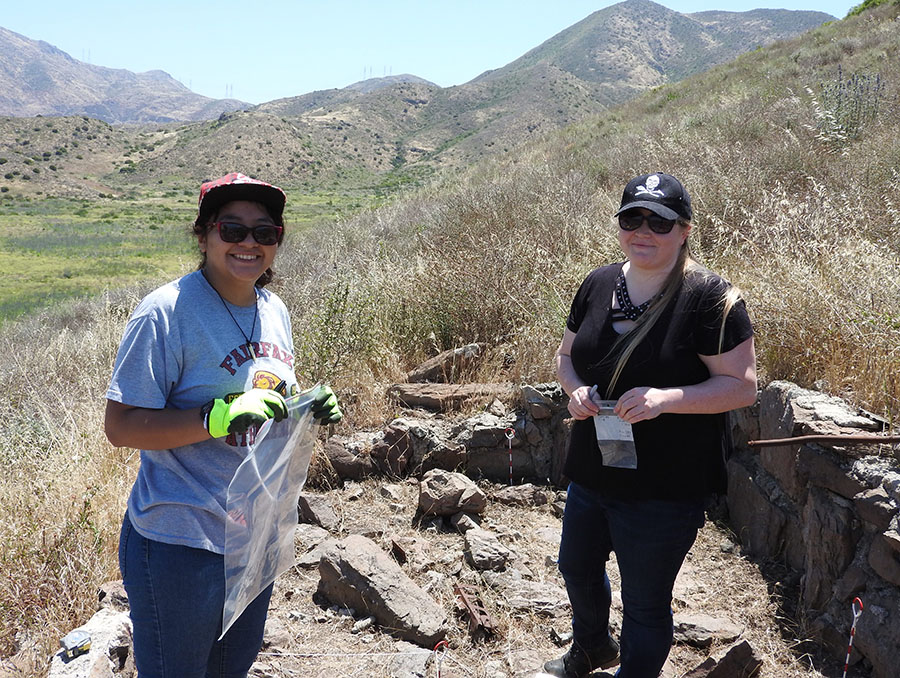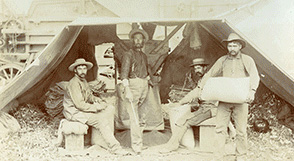 By Kim Lamb Gregory
By Kim Lamb Gregory
July 26, 2023 — After the 2013 Springs Fire stripped the foliage from the hillsides around CSU Channel Islands (CSUCI), Professor of Anthropology Colleen Delaney and six of her students unearthed something mysterious as they began excavating the area. Remnants of Camarillo State Hospital—which occupied the area from 1933 to 1997—were common, but this looked different.
“We found an unusual structure that was made out of volcanic rock and concrete,” Delaney said. “It did not match any of the hospital buildings, so we hoped it dated back even further. Based on some faculty/student research we conducted, it looked like a 1950s work building that didn’t match any of the hospital buildings.”
That unusual find launched Delaney on the trail of the mysterious structure, which she learned was part of a historic ranch named Rancho Guadalasca. She then wrote a book released in May entitled “Rancho Guadalasca: Last Ranch of California's Central Coast,” by The History Press.
Delaney is also planning to launch a lecture series and an exhibit in the John Spoor Broome Library that will be included in the upcoming 150th anniversary celebration of Ventura County.
“I went on sabbatical in 2019 and I started looking for property records and old maps and aerial photographs,” Delaney said. “I wanted to figure out who lived there, who owned it, and what it was used for. It led me down a lot of rabbit holes. The great thing about historical research is you’re always finding new things.”
The tale of Rancho Guadalasca began thousands of years ago with the Indigenous Chumash followed by California farmers and ranchers, Japanese fishermen, Basque sheepherders, Camarillo State Hospital and finally, the CSU Channel Islands campus. All of the people who lived on the ranch property, which lay at the western end of the Santa Monica Mountains along the eastern Oxnard Plain, helped shape Ventura County.
One of the most intriguing characters associated with Rancho Guadalasca was an illiterate but shrewd widow named Ysabel Yorba. Born in 1789 in San Diego and married at 15, Yorba arrived in Ventura County in the early 1800s with her husband, soldier Jose Joaquin Maitorena. They settled at Rancho Guadalasca just before Maitorena was transferred to the Santa Barbara Presidio.
“Her husband was a good soldier, but an alcoholic who wound up in jail and was written up for his behavior,” Delaney said. “He was later elected to congress in Mexico and died there.”
After his death, Yorba ran the ranch for 35 years until shortly before her death at age 82 after it was awarded to her as a Mexican land grant in 1836.
In consultation with the Barbareño/Ventureño Band of Mission Indians, Delaney also researched the first human residents of the area, the Chumash.
The territory of the Guadalasca was important to the Ventureño Chumash. One village in the territory, simo’mo, has the oldest evidence of planked canoes, called tomols. The village of sat’wiwa (also called Round Mountain), is on the CSUCI campus and is sacred to the Chumash.
 When the Spaniards came and the Chumash were removed to missions, the land at Rancho Guadalasca sat untended until Yorba received the land grant. After her death, it was parceled out and sold to investors, ranchers, and farmers, including Ventura County ranching farming pioneer William Richard Broome, who bought 23,000 acres of the ranch in 1880.
When the Spaniards came and the Chumash were removed to missions, the land at Rancho Guadalasca sat untended until Yorba received the land grant. After her death, it was parceled out and sold to investors, ranchers, and farmers, including Ventura County ranching farming pioneer William Richard Broome, who bought 23,000 acres of the ranch in 1880.
His grandson, John “Jack” Spoor Broome, would later help fund construction of the John Spoor Broome Library on the CSUCI campus.
In 1906, Joseph F. Lewis, a business associate of rancher Adolfo Camarillo, bought an 8,200-acre parcel of Rancho Guadalasca and it became the Lewis ranch. The Lewis family owned the ranch until 1931, growing lima beans and sugar beets, and planting orchards of walnuts, and lemons.
The State of California purchased 1,760 acres of the Lewis ranch in 1932, and established Camarillo State Hospital. In 2002, the hospital was transformed into CSUCI, Ventura County’s only four-year public university.
Professor Delaney will be giving a talk about her book on Aug. 19 at 1 p.m. at Bank of Books in Santa Paula, 820 E. Main, Santa Paula, and on Aug. 23, she will give a lecture about Rancho Guadalasca at 5:30 p.m. at the Santa Barbara Presidio at 123 E. Canon Perdido, Santa Barbara.
An exhibit on Rancho Guadalasca will run from Aug. 23 – Dec. 15 at the John Spoor Broome Library.
Historic photo courtesy of Terrance Tally, Joseph Lewis’ great-grandson.
